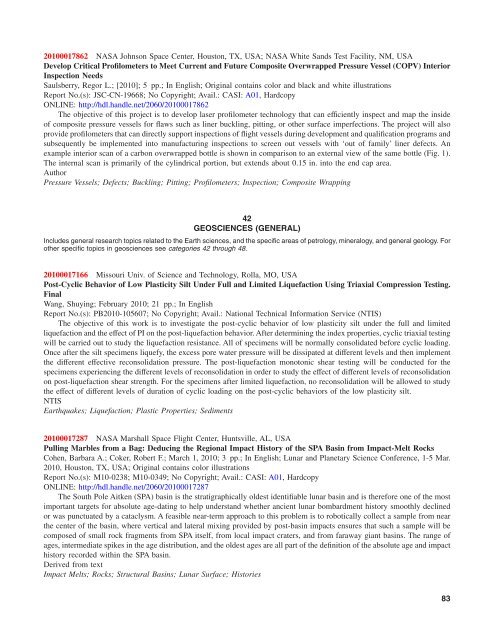NASA Scientific and Technical Aerospace Reports - The University ...
NASA Scientific and Technical Aerospace Reports - The University ...
NASA Scientific and Technical Aerospace Reports - The University ...
Create successful ePaper yourself
Turn your PDF publications into a flip-book with our unique Google optimized e-Paper software.
20100017862 <strong>NASA</strong> Johnson Space Center, Houston, TX, USA; <strong>NASA</strong> White S<strong>and</strong>s Test Facility, NM, USA<br />
Develop Critical Profilometers to Meet Current <strong>and</strong> Future Composite Overwrapped Pressure Vessel (COPV) Interior<br />
Inspection Needs<br />
Saulsberry, Regor L.; [2010]; 5 pp.; In English; Original contains color <strong>and</strong> black <strong>and</strong> white illustrations<br />
Report No.(s): JSC-CN-19668; No Copyright; Avail.: CASI: A01, Hardcopy<br />
ONLINE: http://hdl.h<strong>and</strong>le.net/2060/20100017862<br />
<strong>The</strong> objective of this project is to develop laser profilometer technology that can efficiently inspect <strong>and</strong> map the inside<br />
of composite pressure vessels for flaws such as liner buckling, pitting, or other surface imperfections. <strong>The</strong> project will also<br />
provide profilometers that can directly support inspections of flight vessels during development <strong>and</strong> qualification programs <strong>and</strong><br />
subsequently be implemented into manufacturing inspections to screen out vessels with ‘out of family’ liner defects. An<br />
example interior scan of a carbon overwrapped bottle is shown in comparison to an external view of the same bottle (Fig. 1).<br />
<strong>The</strong> internal scan is primarily of the cylindrical portion, but extends about 0.15 in. into the end cap area.<br />
Author<br />
Pressure Vessels; Defects; Buckling; Pitting; Profilometers; Inspection; Composite Wrapping<br />
42<br />
GEOSCIENCES (GENERAL)<br />
Includes general research topics related to the Earth sciences, <strong>and</strong> the specific areas of petrology, mineralogy, <strong>and</strong> general geology. For<br />
other specific topics in geosciences see categories 42 through 48.<br />
20100017166 Missouri Univ. of Science <strong>and</strong> Technology, Rolla, MO, USA<br />
Post-Cyclic Behavior of Low Plasticity Silt Under Full <strong>and</strong> Limited Liquefaction Using Triaxial Compression Testing.<br />
Final<br />
Wang, Shuying; February 2010; 21 pp.; In English<br />
Report No.(s): PB2010-105607; No Copyright; Avail.: National <strong>Technical</strong> Information Service (NTIS)<br />
<strong>The</strong> objective of this work is to investigate the post-cyclic behavior of low plasticity silt under the full <strong>and</strong> limited<br />
liquefaction <strong>and</strong> the effect of PI on the post-liquefaction behavior. After determining the index properties, cyclic triaxial testing<br />
will be carried out to study the liquefaction resistance. All of specimens will be normally consolidated before cyclic loading.<br />
Once after the silt specimens liquefy, the excess pore water pressure will be dissipated at different levels <strong>and</strong> then implement<br />
the different effective reconsolidation pressure. <strong>The</strong> post-liquefaction monotonic shear testing will be conducted for the<br />
specimens experiencing the different levels of reconsolidation in order to study the effect of different levels of reconsolidation<br />
on post-liquefaction shear strength. For the specimens after limited liquefaction, no reconsolidation will be allowed to study<br />
the effect of different levels of duration of cyclic loading on the post-cyclic behaviors of the low plasticity silt.<br />
NTIS<br />
Earthquakes; Liquefaction; Plastic Properties; Sediments<br />
20100017287 <strong>NASA</strong> Marshall Space Flight Center, Huntsville, AL, USA<br />
Pulling Marbles from a Bag: Deducing the Regional Impact History of the SPA Basin from Impact-Melt Rocks<br />
Cohen, Barbara A.; Coker, Robert F.; March 1, 2010; 3 pp.; In English; Lunar <strong>and</strong> Planetary Science Conference, 1-5 Mar.<br />
2010, Houston, TX, USA; Original contains color illustrations<br />
Report No.(s): M10-0238; M10-0349; No Copyright; Avail.: CASI: A01, Hardcopy<br />
ONLINE: http://hdl.h<strong>and</strong>le.net/2060/20100017287<br />
<strong>The</strong> South Pole Aitken (SPA) basin is the stratigraphically oldest identifiable lunar basin <strong>and</strong> is therefore one of the most<br />
important targets for absolute age-dating to help underst<strong>and</strong> whether ancient lunar bombardment history smoothly declined<br />
or was punctuated by a cataclysm. A feasible near-term approach to this problem is to robotically collect a sample from near<br />
the center of the basin, where vertical <strong>and</strong> lateral mixing provided by post-basin impacts ensures that such a sample will be<br />
composed of small rock fragments from SPA itself, from local impact craters, <strong>and</strong> from faraway giant basins. <strong>The</strong> range of<br />
ages, intermediate spikes in the age distribution, <strong>and</strong> the oldest ages are all part of the definition of the absolute age <strong>and</strong> impact<br />
history recorded within the SPA basin.<br />
Derived from text<br />
Impact Melts; Rocks; Structural Basins; Lunar Surface; Histories<br />
83

















